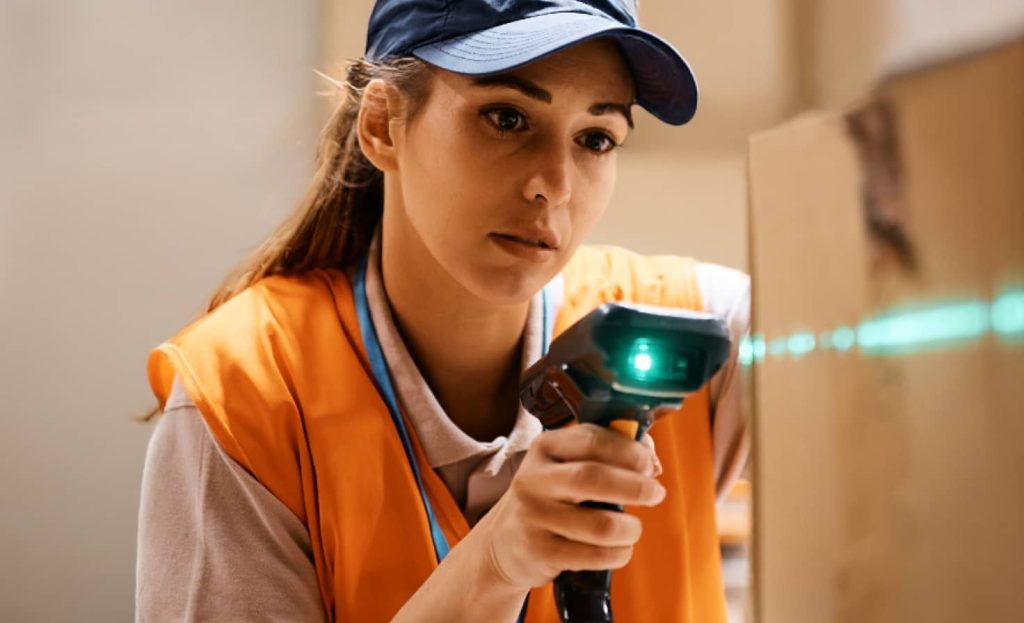
In this article, we’ll explain what HMI software is, how it works, and how custom software development can help companies increase productivity.
- Definition, benefits, and core use cases of HMI software.
- Overview of the three primary HMI system types.
- How HMI solutions advance the objectives of Industry 5.0.
What is HMI software?
A Human–Machine Interface (HMI) is a software that provides a graphical user interface (GUI) enabling operators to control and monitor industrial automation systems and equipment. Modern HMI platforms integrate artificial intelligence (AI), machine learning, and data science technologies.
HMI software presents a unified dashboard through which users can manage and communicate with a single machine, a network of machines, or an entire production system. These dashboards incorporate input/output control functions, real-time data visualisations, and interactive graphical elements to streamline supervision and control.
A familiar consumer-level analogy is an automobile dashboard, where the driver uses buttons, levers, or touchscreen controls to operate vehicle functions such as lighting, audio systems, and climate control, while simultaneously receiving critical feedback on speed, oil temperature, and engine revolutions.
In industrial contexts, HMI software centralises all controls and data visualisation on a single interface, increasing operational efficiency. The interface may be deployed on various hardware platforms: computer monitors, tablets, smartphones, or wearable devices such as head-mounted augmented reality (AR) systems, smart glasses, or industrial-grade goggles. HMI solutions help manufacturing enterprises achieve greater sustainability, agility, and productivity.
How does HMI software work?
Most industrial machinery is governed by a Programmable Logic Controller (PLC), a specialised industrial computer designed to execute automated control functions. HMI solutions interface directly with the PLC, enabling bidirectional communication. When an operator modifies an input via the HMI device, the PLC processes the command and initiates the corresponding output action on the machine.
For example, a conveyor system equipped with a PLC regulate belt speed and directional movement. The operator remotely adjusts these parameters in real time with the help of HMI software.
In addition, PLC systems often incorporate industrial-grade sensors and machine vision cameras to collect operational data and capture images. This data is transmitted to the HMI software and grants the operator enhanced supervisory control and situational awareness over processes.
Contemporary Human–Machine Interface and PLC configurations typically communicate through cloud-based servers and wireless industrial networking protocols, replacing traditional hardwired connections. The HMI dashboard is most often deployed on touchscreen-enabled devices with an intuitive and responsive interface.

How to implement an HMI system
You can set up an HMI system in two main ways:
- Commercial system: Purchased from a provider that specialises in HMI solutions, but often with limited customisation options and less adaptability.
- Custom-built system: Developed by a team of specialists to match the specific needs of your company.
Custom HMI system development process
1. Assessing business needs and goals
The process starts with analysing manufacturing operations, production workflows, and existing challenges to identify areas for improvement. Integration needs for manufacturing systems (MES, SCADA, ERP, PLCs) and potential for IoT and AI/ML are determined. Collaboration with stakeholders clarifies objectives, expected outcomes, and key performance indicators for the custom HMI software.
2. Designing software features and functionality
Based on the assessment, a solution design and system architecture are created to include all necessary features while allowing flexibility for future scaling and modifications. Security is prioritised at every level, with adherence to manufacturing standards (ISO 9001, IEC 62443, GMP). The design follows industry best practices and supports easy integration of new technologies as the manufacturing environment evolves.
3. Planning and executing the implementation
A clear implementation plan is developed to ensure smooth deployment without interrupting operations. Quality assurance and testing occur at every stage, including validation for regulatory compliance. This approach allows optimisation and refinement before the full rollout.
4. Integrating with existing systems
The new software is integrated with existing manufacturing execution systems, maintaining data security and integrity throughout. Seamless data flow is established between shop floor equipment, SCADA systems, and enterprise applications, with robust security measures protecting sensitive information during integration and migration.
5. Support and training for end-users
Training sessions and workshops are tailored to different user groups to promote rapid adoption. This includes specialised training for production operators, quality control personnel, and management teams. Ongoing support helps address issues and maximise the value of the software solution.
The three main types of HMI systems
Data Handler
is best suited for operations requiring extensive data acquisition, monitoring, and reporting. An HMI configuration for data handling includes capabilities such as data logging, alarm management, trend visualisation, and the display of performance metrics through charts and graphs.
Pushbutton Replacer
is a digital replacement for traditional mechanical controls, consolidating all machine functions within a single interface. It allows operators to execute commands such as start/stop, mode selection, and other control actions from one centralised location.
Overseer
is implemented in Windows-based environments and on mobile devices; the overseer interface offers a highly visual and interactive user experience. It is effective for supervisory functions in large-scale production environments, such as manufacturing execution systems (MES) or supervisory control and data acquisition systems.
HMI software use cases
Computer Numerical Control (CNC) lathes are machines that rotate a piece of material at high speed and apply cutting tools to shape and finish it. Until recently, CNC lathes have used large consoles with buttons, LEDs, and a stationary computer monitor or built-in screen.
Machine-level HMI solutions can help to make CNC lathes easier to operate and monitor. Manufacturing businesses that have implemented HMI software to control CNC lathes report that it also helps to reduce errors, boost productivity, and increase machine reliability.
The production of plastic moulds can be hazardous due to the use of toxic chemicals and high temperatures. HMI software can integrate with a PLC system to provide full motion and temperature control and monitoring for processes such as injection moulding, extrusion, or thermoforming.
Most medium to large-scale assembly lines use robotic automation these days. Although many of the tasks are fully automated and do not require human control, some operations still need human involvement and machine supervision. HMI software can be integrated with Augmented Reality (AR) solutions to make hazardous assembly tasks much safer, as the engineer or operator can carry out the task remotely.
Benefits of custom HMI software development
- Enhanced usability and operator experience: HMI solutions offer an intuitive touchscreen interface compared to the complexity of conventional industrial control systems. This reduces cognitive load and shortens the learning curve for operators. HMI software can be designed to match the operator's workflow precisely with the help of UX consulting and product-oriented delivery.
- Increased productivity and operational efficiency: By consolidating all control, monitoring, and diagnostic functions into a single, unified dashboard, HMI software eliminates the inefficiencies caused by dispersed control panels and manual process checks. This centralisation enables operators to manage multiple machines or production lines from one location, significantly reducing downtime. Leveraging cloud computing and enterprise applications integration further ensures that real-time data is accessible across the entire production ecosystem.
- Improved workforce safety: HMI systems enhance industrial safety as they enable remote machine operation via wireless devices. It minimises direct human interaction with potentially hazardous equipment. Additionally, camera-based inspections and AI-powered anomaly detection allow the identification of safety risks without physical proximity to machinery. For operations involving hazardous materials, this reduces the risk of exposure and injury.
- Reduction in human error: Automation of routine control functions and implementation of intelligent safeguards lead to a reduction in operator mistakes. Advanced HMI systems can incorporate intelligent automation and MLOps capabilities to override unsafe commands and validate operational parameters. The intuitive interface designed with human-centred UX principles further minimises the potential for errors and missed notifications.
- Optimised operational costs: Many of the benefits above contribute directly to cost reduction. Increased machine uptime, improved reliability, and streamlined operator training translate into lower maintenance expenses and reduced training overhead. With software audit and quality assurance services, organisations can ensure that the HMI system remains secure and stable throughout its lifecycle.
- High Return on Investment (ROI): Custom HMI software offers strong ROI potential. The initial investment covering solution design, development, deployment, and mobile HMI device procurement is quickly offset by efficiency gains, reduced downtime, and lower maintenance costs. Utilising technical feasibility studies and product and service design ensures that the solution is strategically aligned with operational goals.
The difference between HMI and SCADA
A Supervisory Control and Data Acquisition (SCADA) system comprises both physical field devices, such as sensors, actuators, and programmable logic controllers (PLCs) and a centralised control unit that incorporates a Human-Machine Interface (HMI). The HMI component serves as the operator interface, enabling interaction with plant equipment, process visualisation, and command execution.
The HMI is an integral part of the SCADA architecture. The HMI functions as the user-facing layer within SCADA, whereas SCADA encompasses the complete supervisory system, including data acquisition, real-time monitoring, process control, and historical data management. In other words, an HMI can be part of a SCADA system, but a SCADA system, by definition, cannot be a subset of an HMI.
How HMI software enables smart manufacturing
The machine-level HMI solution represents a natural evolution from traditional manually operated controls to modern digital factories. Data engineering underpins this shift by collecting, cleaning, and integrating massive volumes of machine and sensor data into structured formats that HMI dashboards display in real time.
When integrated with ERP (Enterprise Resource Planning) systems, HMI software can extend its benefits beyond the shop floor. Real-time production data from HMI dashboards can feed directly into ERP modules for inventory management, procurement, scheduling, and quality control. This integration closes the loop between operational technology (OT) and business systems.
Final thoughts
Human-Machine Interface software represents a key advancement in the supervisory control and monitoring of industrial processes and machinery. In recent years, the integration of emerging technologies such as AI and ML has accelerated the digital transformation within the manufacturing sector.
The benefits are obvious: improved productivity and efficiency, reduced costs, increased reliability, and safer working environments.

HMI stands for Human-Machine Interface, a type of software that lets operators interact with industrial machines and equipment using a simple user interface. These interfaces can work with PC monitors, tablets, smartphones, or AR and VR headsets. Integrating HMI solutions into manufacturing environments, engineers can control machinery, monitor manufacturing processes with a SCADA system, and get real-time feedback on equipment performance.
HMI programming software is used to design custom graphical interfaces that allow operators to control and monitor industrial machinery. HMI development experts can create interactive dashboards that display live data and connect to Programmable Logic Controllers (PLCs) to manage machine operations. Key HMI system features include data logging, alarms, trend visualisation, and functionality for remote system control.
There are several approaches to HMI design and programming; each depends on project requirements, budget, software complexity, manufacturing environment, hardware components and specific industrial control needs. HMI developers can use scripting languages like Python and JavaScript, graphical programming languages like LabVIEW and MATLAB, or HMI-specific tools like FactoryTalk View and WinCC. Each approach has its advantages and limitations. Scripting languages provide flexibility, graphical languages offer intuitive visual programming capabilities, and HMI-specific tools deliver ready-made templates and industrial communication protocols.
- A PLC (Programmable Logic Controller) is a device that controls machines by executing programmed instructions.
- An HMI (Human Machine Interface) is the user interface that allows operators to monitor and control the machines easily.
In short, the PLC runs the machine, and the HMI helps people interact with it.
Related Insights








The breadth of knowledge and understanding that ELEKS has within its walls allows us to leverage that expertise to make superior deliverables for our customers. When you work with ELEKS, you are working with the top 1% of the aptitude and engineering excellence of the whole country.

Right from the start, we really liked ELEKS’ commitment and engagement. They came to us with their best people to try to understand our context, our business idea, and developed the first prototype with us. They were very professional and very customer oriented. I think, without ELEKS it probably would not have been possible to have such a successful product in such a short period of time.

ELEKS has been involved in the development of a number of our consumer-facing websites and mobile applications that allow our customers to easily track their shipments, get the information they need as well as stay in touch with us. We’ve appreciated the level of ELEKS’ expertise, responsiveness and attention to details.

